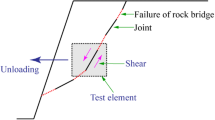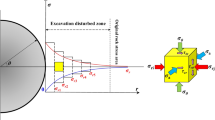Abstract
Due to the excavation disturbance in deep tunnel, the stress magnitude and orientation changed obviously, which affects the mechanical properties of surrounding rock and the stability of tunnel. The axial–torsional test is adopted to study the influence of stress orientation on the strength and deformation behavior of four sandstones, using the self-developed hollow cylinder torsional apparatus for rock. The results show that the peak shear strength of sandstone is nonlinear, positively correlated with axial stress, and negatively correlated with the rotation angle of the principal stress axis. The stress–strain curve obtained under the rotation of principal stress axis can be divided into compaction, elasticity, yield, and softening stages. Furthermore, the sensitivity of the crack damage threshold of various sandstone is analyzed. The results show that the rotation of the principal stress axis can aggravate rock damage, and the greater the initial damage degree, the stronger the impact. Finally, the evolution mechanism of the internal rock cracks under the axial–torsional test is discussed by analyzing the rock failure characteristics, and it can be seen that the initiation, propagation, and coalescence of cracks are not only affected by stress magnitude, but also the stress orientation. Moreover, the crack propagation model considering principal stress axis rotation is verified and improved experimentally. The results of this research are of great significance to studying the influence of stress orientation and provide an important method to investigate the mechanical properties of rock with complex stress states comprehensively.










Similar content being viewed by others
Data Availability
The data that support the findings of this study are available from the corresponding author, Hui Zhou (hzhou@whrsm.ac.cn), upon reasonable request.
Abbreviations
- c :
-
Cohesion
- φ :
-
Internal friction angle
- F :
-
Axial force
- M t :
-
Torque
- σc :
-
The uniaxial compression strength
- σz :
-
Axial stress
- σθ :
-
Circumferential stress
- τz θ :
-
Shear stress
- γzθ :
-
Shear strain
- σ1 :
-
The maximum principal stress
- σ2 :
-
The intermediate principal stress
- σ3 :
-
The minimum principal stress
- α:
-
Principal stress rotation angle
- p :
-
Mean stress
- q J :
-
Generalized shear stress
- γg :
-
Generalized shear strain
- n :
-
Axial compression ratio
- L :
-
Length of the torque arm
- D :
-
Diameter of the axial loading piston
- R :
-
Radius of the piston in the torque hydraulic jack
References
Abel JF, Lee FT (1973) Stress changes ahead of an advancing tunnel. Int J of Rock Mech Min Sci 10(6):673–697
Alsayed MI (2002) Utilising the Hoek triaxial cell for multiaxial testing of hollow rock cylinders. Int J Rock Mech Min Sci 39(3):355–366
Cui W, Wang N (2014) Principal stress axis rotation and effect on failure model of surrounding rock during tunnelling. J Cent South Univ (Sci Tech) 45(6):2062–2070 (in Chinese)
Diederichs MS, Kaiser PK, Eberhardt E (2004) Damage initiation and propagation in hard rock during tunneling and the influence of near face stress rotation. Int J Rock Mech Min Sci 41(5):785–812
Diederichs MS (2000) Instability of hard rock masses: the role of tensile damage and relaxation. PhD thesis, University of Waterloo. http://hdl.handle.net/10012/480
Dunning J, Douglas B, Miller M, Mcdonald S (1994) The role of the chemical environment in frictional deformation: stress corrosion cracking and comminution. Pure Appl Geophys 143(1):151–178
Eberhardt E (2001) Numerical modeling of three-dimensional stress rotation ahead of an advancing tunnel face. Int J Rock Mech Min Sci 38(4):499–518
Feng XT, Chen SL, Zhou H (2004) Real-time computerized tomography (CT) experiments on sandstone damage evolution during triaxial compression with chemical corrosion. Int J Rock Mech Min Sci 41(2):181–192
Feucht LJ, Logan JM (1990) Effects of chemically active solutions on shearing behavior of a sandstone. Tectonophysics 175(1/3):159–176
Hight D, Gens A, Symes M (1983) The development of a new hollow cylinder apparatus for investigating the effects of principal stress rotation in soils. Geotechnique 33(4):355–383
Hu DW, Zhou H, Zhang F, Shao JF (2010) Evolution of poroelastic properties and permeability in damaged sandstone. Int J Rock Mech Min Sci 47(6):962–973
Hu SC, Tan YL, Zhou H, Guo WY, Hu DW, Meng FZ, Liu ZG (2017) Impact of bedding planes on mechanical properties of sandstone. Rock Mech Rock Eng 50:2243–2251
Jiang Y, Zhou H, Lu JJ, Gao Y, Zhang CQ, Chen J (2019) Analysis of stress evolution characteristics during TBM excavation in deep buried tunnels. Bull Eng Geol Environ 78:5177–5194
Jiang Y, Zhou H, Lu JJ, Gao Y (2023) Experimental study of hollow-cylinder sandstone under constant mean stress considering the rotation of principal stress axes. Rock Mech Rock Eng 56:3231–3238. https://doi.org/10.1007/s00603-022-03197-9
Kaiser PK, Yazici S, Maloney S (2001) Mining induced stress change and consequences of stress path on excavation stability: A case study. Int J Rock Mech Min Sci 38(2):167–180
Lee DH, Juang CH, Chen JW, Lin HM, Shieh WH (1999) Stress paths and mechanical behavior of a sandstone in hollow cylinder tests. Int J Rock Mech Min Sci 36:857–870
Li XB, Zhou ZL, Lok TS, Huang L, Yin TB (2008) Innovative testing technique of rock subjected to coupled static and dynamic loads. Int J Rock Mech Min Sci 45(5):739–748
Li XB, Fengqiang G, Ming T, Dong Longjun Du, Kun MC, Zilong Z, Tubing Y (2017) Failure mechanism and coupled static-dynamic loading theory in deep hard rock mining: a review. J Rock Mech Geotech Eng 9(4):767–782
Li T, Pei X, Guo J, Meng M, Huang R (2020a) An energy-based fatigue damage model for sandstone subjected to cyclic loading. Rock Mech Rock Eng 53:5069–5079
Li M, Wang D, Shao Z (2020) Experimental study on changes of pore structure and mechanical properties of sandstone after high-temperature treatment using nuclear magnetic resonance. Eng Geol 275:105739. https://doi.org/10.1016/j.enggeo.2020.105739
Logan JM, Blackwell MI (1983) The influence of chemically active fluids on frictional behavior of sandstone. EOS, Trans Am Geophys Union 64(2):835–837
Qian QH, Li SC (2008) A review of research on zonal disintegration phenomenon in deep rock mass engineering. Chin J Rock Mech Eng 27(6):1278–1284 (in Chinese)
Sayao A, Vaid Y (1991) A critical assessment of stress nonuniformities in hollow cylinder test specimens. Can Geotech J 31(1):60–72
Vaid Y, Sayao A, Hou E et al (1990) Generalized stress-path-dependent soil behaviour with a new hollow cylinder torsional apparatus. Can Geotech J 27(5):601–616
Wang S, Xu W, Jia C, Wang W (2017) Mechanical behavior of fine-grained sandstone in triaxial compression and elastoplastic modeling by return mapping algorithms. Bull Eng Geol Environ 77:1689–1699
Wasantha PLP, Ranjith PG, Zhao J, Shao SS, Permata G (2015) Strain rate effect on the mechanical behaviour of sandstones with different grain sizes. Rock Mech Rock Eng 48:1883–1895
Xu P, Yang SQ (2016) Permeability evolution of sandstone under short-term and long-term triaxial compression. Int J Rock Mech Min Sci 85:152–164
Xu J, Li H, Xian XF, Yin GZ (1986) Meso-mechanical experiment of micro fracturing progress of sandstone under uniaxial stress condition. Mech Eng 8(4):16–20 (in Chinese)
Xue L, Qin SQ, Sun Q, Li WC (2014) A study on crack damage stress thresholds of different rock types based on uniaxial compression tests. Rock Mech Rock Eng 47:1183–1195
Yang SQ (2016) Experimental study on deformation, peak strength and crack damage behavior of hollow sandstone under conventional triaxial compression. Eng Geol 213:11–24
Yang SQ, Jing HW (2013) Evaluation on strength and deformation behavior of red sandstone under simple and complex loading paths. Eng Geol 164:1–17
Yang SQ, Jing HW, Wang SY (2012) Experimental investigation on the strength, deformability, failure behavior and acoustic emission locations of red sandstone under triaxial compression. Rock Mech Rock Eng 45:583–606
Yang SQ, Ranjith PG, Gui YL (2015) Experimental study of mechanical behavior and X-ray micro CT observations of sandstone under conventional triaxial compression. Geotech Test J 38(2):179–197
Yang SQ, Xu P, Li YB, Huang YH (2017) Experimental investigation on triaxial mechanical and permeability behavior of sandstone after exposure to different high temperature treatments. Geothermics 69:93–109
Yi C, Johansson D, Greberg J (2017) Effects of in-situ stresses on the fracturing of rock by blasting. Comput Geotech 104(DEC.):321–330
Zhang SR, Liang LH (2007) Analysis on tunnel liner supporting time considering three-dimensional stress rotation. J Hydrol Eng 38(6):704–709 (in Chinese)
Zhang C, Zhou H, Feng X, Xing L, Qiu S (2013) Layered fractures induced by principal stress axes rotation in hard rock during tunnelling. Mater Res Innov 15(sup1):527–530
Zhou H, Jiang Y, Lu JJ, Gao Y, Chen J (2018a) Development of a hollow cylinder torsional apparatus for rock. Rock Mech Rock Eng 51:3845
Zhou H, Jiang Y, Lu JJ, Hu DW, Zhang CQ, Chen J, Li Z (2018) Study of hollow cylinder torsional apparatus for rock. Rock Soil Mech 40(5):1917–1922 (in Chinese)
Zou D, Kaiser PK (1990) Determination of in situ stresses from excavation-induced stress changes. Rock Mech Rock Eng 23(3):167–184
Acknowledgements
The authors would like to thank the financial supports provided by National Natural Science Foundation of China (NSFC) (42102307, 52009128); Open Research Fund of State Key Laboratory of Geomechanics and Geotechnical Engineering, Institute of Rock and Soil Mechanics, Chinese Academy of Sciences Grant (Z2019023); Natural Science Foundation of Jiangsu Province (BK20209992); and Jiangsu Province High-level Innovative and Entrepreneurial Talent Introduction Plan. Besides, the authors are also grateful to the anonymous reviewers for their careful reading of our manuscript and their many helpful comments.
Author information
Authors and Affiliations
Corresponding author
Ethics declarations
Competing interests
The authors declare no competing interests.
Rights and permissions
Springer Nature or its licensor (e.g. a society or other partner) holds exclusive rights to this article under a publishing agreement with the author(s) or other rightsholder(s); author self-archiving of the accepted manuscript version of this article is solely governed by the terms of such publishing agreement and applicable law.
About this article
Cite this article
Jiang, Y., Zhou, H., Lu, J. et al. Strength, deformation, and failure characteristics of hollow cylinder sandstone under axial–torsional tests. Bull Eng Geol Environ 82, 296 (2023). https://doi.org/10.1007/s10064-023-03295-0
Received:
Accepted:
Published:
DOI: https://doi.org/10.1007/s10064-023-03295-0




